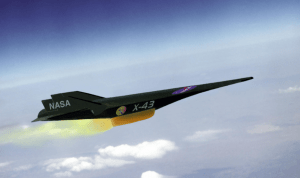University of Iowa Researcher Receives $2.2M in Grant Funding for Hypersonics Research
University of Iowa Professor of Mechanical Engineering H.S. Udaykumar has received research funding totaling more than $2.2 million to develop innovative new materials for hypersonic aircraft.
Udaykumar’s research uses artificial intelligence (AI) and advanced computer simulations to explore new materials that can withstand extreme and conflicting conditions.
Udaykumar, who is also associate dean for graduate programs, research, and faculty as well as a research engineer at IIHR—Hydroscience and Engineering, is exploring hypersonics as part of two research projects: $1.5 million in support from the University Consortium for Applied Hypersonics (research he leads as principal investigator) and $764,000 from the National Science Foundation.
Many people may remember the supersonic commercial airliner Concorde, which flew from New York to London in just under three hours at a top speed of 1,350 miles per hour (Mach 2). Hypersonic refers to flight speeds of about 5 to 10 times the speed of sound, or Mach 5 to Mach 10.
Hypersonic flight is a hot research area worldwide that will require new materials, Udaykumar explains, because the conditions the aircraft face are so extreme: high altitude, very cold ambient temperatures, and intense heat on the exterior skin. The engines also run at high temperatures, and the materials used to build them must be lightweight, durable, and resilient to extreme heat and pressure.

An artist’s conception of the X-43A Hypersonic Experimental Vehicle, or “Hyper-X” in flight. Image courtesy of NASA
“Very few metals can withstand those kinds of conditions over many operational cycles,” Udaykumar says. New materials designed for hypersonic applications will likely involve novel combination of metals, ceramics, and polymers.
Udaykumar’s research, conducted with collaborator Stephen Baek at the University of Virginia, will use artificial intelligence (AI) and advanced computer simulations to explore new materials that can withstand these extreme and conflicting conditions.
“One of the things we have been looking at is how to engineer materials at the microstructural level,” Udaykumar says. These grain structures and microstructures are at the scale of hundreds of microns; they determine the material’s strength and durability, as well as its behavior under stress and thermal cycles. Using AI and numerical simulations, Udaykumar hopes to design materials that can function under the extreme conditions of hypersonic flight.
“This is what we call materials by design,” Udaykumar says.
The technique of using AI and computational simulations allows the researchers to rapidly develop high-performance design loops. They can then quickly discard the designs that do not work and focus on more promising options, which can be prototyped quickly.
Udaykumar says that he and his colleagues at Iowa and many other research groups across the nation are pushing the envelope of flight. “It’s a huge challenge,” he adds.
The first application of hypersonics is likely to be for the military, but Udaykumar predicts that it will spin off to commercial and civilian technologies. “The challenges are the same,” he says.
The University Consortium for Applied Hypersonics, administered by Texas A&M, is a U.S. Department of Defense–funded consortium for modernizing hypersonic flight capabilities. Udaykumar’s project partners include the University of Virginia, Purdue University, and the New Mexico Institute of Mining and Technologies.
Read more about the NSF grant: https://www.nsf.gov/awardsearch/




